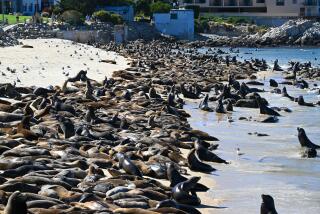Researchers Patrol Mexico Beaches to Save Sea Turtles : Poachers: Squads of volunteers keep watch on nesting grounds of imperiled breed to protect eggs, ward off raiders.
- Share via
PUERTO AVENTURAS, Mexico — Squads of turtle watchers armed with flashlights and buckets patrol the beaches of Mexico’s Yucatan Peninsula to protect the dwindling numbers of sea turtles that use Caribbean shores as a nesting ground.
The small bands of beachcombers are on duty from dusk until early morning during the summer breeding season, warding off poachers and collecting turtle eggs for safekeeping in man-made nests enclosed by fences.
President Carlos Salinas de Gortari, who has vowed to strengthen environmental programs, has signed a decree outlawing the killing of sea turtles. But the animals who nest south of Cancun’s booming resort beaches continue to be threatened by the steady advance of property development.
“In the state of Quintana Roo the biggest pressure being put on the sea turtles comes from tourist development,” said project director Julio Cesar Zurita.
Zurita, a researcher with the Quintana Roo Investigation Center, said the patrols are a last-ditch effort to save the reptiles, which live in the sea but have been lumbering onto dry land to deposit their eggs since the time of the dinosaurs.
Teams of students and volunteers watch silently in the dark as female turtles crawl onto the beach, always after nightfall, to scoop out shallow nests and lay their eggs.
When the turtle finishes her night’s work, the flashlight is turned on and the researchers measure and tag the mother before turning her loose.
They then carefully dig up the eggs and carry them back to an enclosed area where they are buried in a site identified by a numbered marker. The eggs are then monitored until they hatch about 55 days later.
Last year the government-funded project produced about 100,000 baby turtles which were released immediately to begin their lives in the ocean.
But Zurita estimates that only one in a thousand survives to maturity because the infant turtles often fall prey to predators--both birds and fish.
A poacher can earn 20 to 50 times a day’s minimum wage by selling the meat of one turtle. Even if the mother gets away, the hunters can turn a profit from plundering the nest and selling the eggs, which have been a prized food in Mexico since the days of the ancient Mayas.
Some of the turtle egg’s attraction was based on what scientists describe as a mistaken belief that it acts as a sexual stimulant for humans.
The government has introduced a national television campaign that warns the public against eating the eggs, saying they contain dangerously high levels of cholesterol.
Researchers say about 400 green turtles and 500 loggerhead turtles lay their eggs each year along the stretch of beach south of Cancun--where thousands once dug nests in the sand.
Nine of the 11 sea turtle species and subspecies reproduce along Mexico’s Atlantic and Pacific coasts, according to the fishing ministry, but years of hunting and development have taken a heavy toll on the turtle population.
The international environmental group Greenpeace estimates that 2 million Olive Ridley turtles have been killed in Mexico since 1970 as the demand for their skins exploded abroad, principally in Japan.
But the future of the four species that nest in Quintana Roo may depend less on the greed of poachers than on the influx of sun worshipers lured by the state’s brilliant blue waters and white beaches.
The seaside settlement of Akumal still bears a Maya name meaning “place of the turtles,” but researchers say sea turtles have almost disappeared there.
Further south along the coast, at Puerto Aventuras, some of the sand from the beach has been redistributed along the waterfront as part of a holiday complex project under construction.
The area was once an active nesting ground for sea turtles, but Zurita predicted that the animals will cease to lay their eggs there within a few years because of development.
The effects of encroaching civilization are felt in a variety of ways. Some of the turtles that hatch within miles of Cancun, Mexico’s premier tourist resort, become disoriented from the artificial lights that line the streets and miscalculate when they dash for the sea.
The extremely light-sensitive turtles head in the wrong direction and die without ever reaching the ocean.
“We’ve found their dehydrated bodies out by the highway,” Zurita said.
More to Read
Sign up for Essential California
The most important California stories and recommendations in your inbox every morning.
You may occasionally receive promotional content from the Los Angeles Times.













